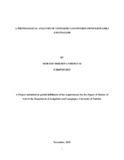| dc.description.abstract | This research discusses the phonological adaptations of Kiswahili and English loanwords into Lwidakho within the Optimality Theory framework as espoused by Allan Prince and Paul Smolensky (1993, 2002). It outlines the Lwidakho sound inventory. The study investigates the constraints responsible for the systematic adaptation of English and Kiswahili consonant segments together with the syllable structures into Lwidakho. The data was collected through natural observation and introspection. Optimality tables are used in the ranking of constraints undergirding the phonological adaptations. The findings of the study point to substitution as the process by which foreign sound segments are adapted into Lwidakho. Secondly, Kiswahili and English syllable structures are changed into CV syllables in Lwidakho. Lastly, vowel epenthesis as opposed to consonant deletion is the most preferred repair strategy for illicit codas and consonant clusters in Lwidakho. The present study contributes to the documentation of the Lwidakho language especially in loanword phonology. | en_US |

